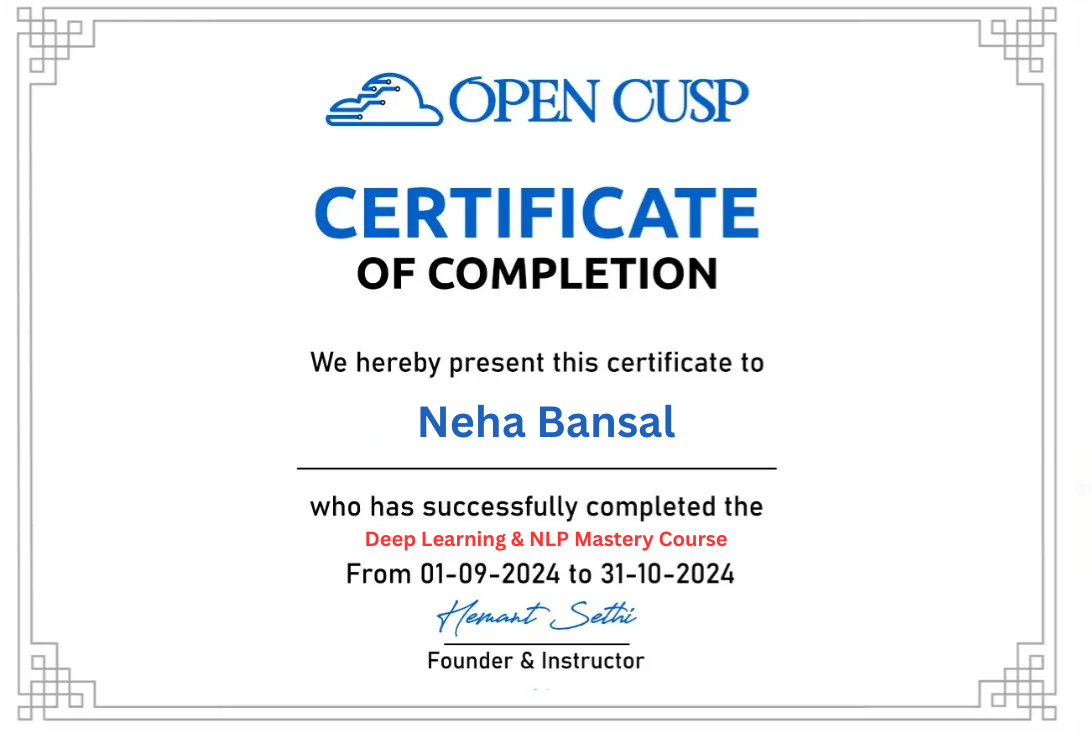What will you learn?
Learn neural networks from scratch to advanced, using real-world coding in PyTorch.
Build AI models like CNNs, RNNs, and Transformers with project-based training.
Master Deep Learning techniques like regularization, tuning, and model optimization.
Apply NLP & DL skills to solve real problems in computer vision and text analytics.
Course Content for Deep Learning & NLP Mastery
- Introduction to Deep Learning
- Applications of Neural Networks
- Setting up environment (Python, Jupyter, PyTorch installation)
- Overview of Machine Learning vs Deep Learning
- What is a Neural Network?
- Neurons and Activation Functions
- Architecture of Neural Networks (Layers, Weights, Biases)
- Forward Pass and Backward Pass Basics
- Introduction to PyTorch framework
- Tensors in PyTorch: Creation and Operations
- GPU acceleration basics (moving tensors to GPU)
- Building simple computational graphs
- Understanding Autograd and automatic differentiation
- Forward Propagation and Loss Calculation
- Backpropagation Algorithm
- Gradient Descent and Variants (SGD, Adam, RMSprop)
- Cost function types (MSE, Cross-Entropy Loss)
- Building Neural Networks with torch.nn
- Defining the Model, Loss Function, and Optimizer
- Training loop: forward, loss computation, backward, update
- Saving and loading models
- Stochastic Gradient Descent (SGD)
- Mini-batch Gradient Descent
- Momentum, Nesterov Accelerated Gradient
- Adam, RMSprop, and other optimizers
- Choosing the right optimizer for your problem
- Overfitting and Underfitting
- L1 and L2 Regularization
- Dropout Technique
- Early Stopping
- Data Augmentation strategies
- Importance of Hyperparameters
- Techniques: Grid Search, Random Search, Bayesian Optimization
- Tuning learning rate, batch size, epochs
- Tips for effective tuning and avoiding overfitting
- Basics of image data and CNN architecture
- Convolution layers, Filters/Kernels, Padding, Stride
- Pooling Layers (Max Pooling, Average Pooling)
- Flattening and Fully Connected Layers
- Building CNNs with PyTorch
- Understanding sequential data (text, time-series)
- Recurrent Neural Networks (RNN) basics
- Problems of RNN: Vanishing Gradient, Exploding Gradient
- Introduction to LSTM (Long Short-Term Memory)
- GRU (Gated Recurrent Units)
- Limitations of RNNs and LSTMs
- Introduction to Attention Mechanism
- Transformer architecture in depth (Encoder-Decoder)
- Self-Attention and Multi-Head Attention
- Positional Encoding
- Understanding the manufacturing defect image dataset
- Data preprocessing and real-time augmentation
- Building a CNN model for defect classification
- Training the model for low-latency predictions
- Deploying the model for real-time video/image feeds
- Visualizing detections and generating automated reports
- What is Natural Language Processing (NLP)?
- Applications of NLP (chatbots, translation, sentiment analysis)
- Challenges in NLP (ambiguity, context understanding)
- Structured vs Unstructured data
- NLP pipeline overview (preprocessing → modeling → evaluation)
- Tokenization Techniques
- Word Tokenizer vs Sentence Tokenizer
- Tokenization in Spacy
- Stemming & Lemmatization
- Part of Speech (POS) Tagging
- Stop Words removal
- Named Entity Recognition (NER)
- Regular Expressions (Regex) for text processing
- Why convert text to numbers?
- One-Hot Encoding
- Bag of Words (BoW)
- Term Frequency-Inverse Document Frequency (TF-IDF)
- Word Embeddings (Word2Vec, GloVe)
- Contextual Embeddings (ELMo, BERT)
- Dimensionality reduction for text features
- Introduction to Hugging Face library
- Loading pre-trained transformer models (BERT, DistilBERT)
- Fine-tuning transformer models for text classification
- Tokenization using Hugging Face Tokenizers
- Text generation using GPT models
- Sentiment analysis using pre-built pipelines
- Named Entity Recognition using Hugging Face models
- Best practices for deploying NLP models
Requirements
Everything You Need to Get Started:Knowledge of Python programming is recommended to follow ML code and use key libraries.
Understanding of linear algebra, calculus, and probability helps in learning deep learning techniques.
Familiarity with machine learning basics like regression and classification is required.
Strong interest in AI, Deep Learning, and NLP, with a commitment to hands-on practice, is essential.
Meet your instructor


Mr. Hitesh Gudwani
AI Expert | 20+ Years of Experience in ML, DL, NLP & Generative AIHitesh is an experienced AI professional specializing in Machine Learning, Deep Learning, Natural Language Processing, and Generative AI. With a passion for teaching, he makes complex AI topics simple and practical. Hitesh empowers learners to build real-world AI solutions and succeed in the fast-growing field of artificial intelligence.

Buy for 10% off
This course includes:
45+ Hours of Live Deep Learning & NLP Classes led by industry experts in real-time sessions.
Hands-On NLP Projects with model building and practical use-case implementation.
Interview Preparation for AI Roles including mock interviews, resume help, and recruiter tips.
Model Deployment Training to implement and scale AI solutions in production.

